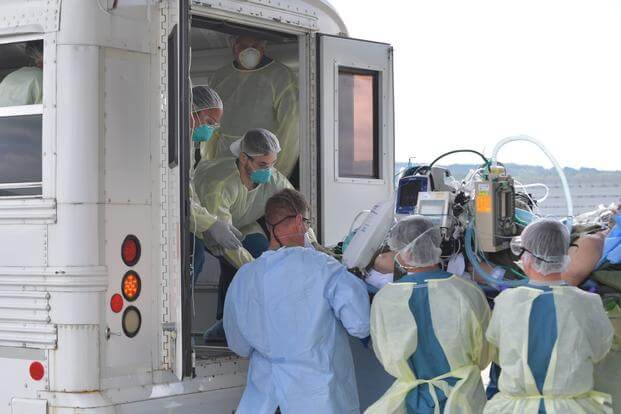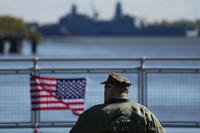Weeks after testing a reconfigured shipping container that can safely isolate infected personnel on an aircraft, the U.S. Air Force on Wednesday moved 12 patients out of the Middle East to Germany in its first transport using the containment device.
Known as the negatively pressurized conex, or NPC, the chamber was loaded onto a C-17 Globemaster III to transport the dozen personnel who will receive more effective coronavirus treatment at Landstuhl Regional Medical Center, according to a service release.
Read Next: Army Investigating Fort Hood Sexual Assault Response Program After Soldier's Disappearance
The NPC can carry up to 28 COVID-19 patients, or those harboring other infectious diseases, without spreading the disease to the aircrew. The box can be arranged to carry ambulatory patients, or to hold litters or bunk-bed-like cots -- or a combination of the two. The isolation chamber was first tested at Joint Base Charleston in April.
"This was definitely not your typical patient movement mission," Maj. Benjamin Weaver, bioenvironmental engineer and 10th Expeditionary Aeromedical Evacuation Flight NPC support team lead, said in the release. "It was a long 22 hours for everyone involved, but the NPC and team performed exceptionally well to make it happen."
The NPC was brought to Ramstein Air Base from Joint Base Charleston, where the 521st Air Mobility Operations Wing trained personnel and sanitized the aircraft ahead of the mission.
The latest operation "brings the total number of patients retrieved by the Mobility Air Force using an isolation containment chamber to more than 100 across 18 missions since the COVID-19 pandemic began," the release said.
The other containment chamber transports have involved the Transport Isolation System, or TIS, which was used in April for the first time since the 2014 Ebola outbreak to carry three U.S. government contractors who tested positive for coronavirus aboard a C-17 from Afghanistan to Landstuhl during the onset of the COVID outbreak. The TIS, however, can carry only two to four patients within the airlocked unit.
Air Mobility Command officials said since the April 10 mission, the TIS has been used 16 additional times for aeromedical evacuations.
In addition to a number of academics and contractors, the effort to create the NPC -- classified as a joint urgent operational need -- included Eglin Air Force Base's Air Force Operational Test and Evaluation Center's (AFOTEC) Det. 2 and the 28th Test and Evaluation Squadron; and chemical, biological, radiological and nuclear (CBRN) defense teams.
"Watching the team come together to train on this system in theater and then fly its first mission shows what can be accomplished when whole-of-government and industry partners work selflessly, sacrificing long hours and personal time in order to produce a solution that save[s] lives," said Capt. Alexis Todaro, NPC program manager who delivered the NPC to Ramstein Air Base for training and site activation. "It took a team of teams to get NPC from a concept to operational in under 100 days."
Authorized to fly aboard the C-17, crews are now conducting testing for certification on the C-5M Super Galaxy. Additionally, the Air Force last week certified a smaller version, NPC-Lite, that can be used aboard the C-130 Hercules, officials said.
"I'm impressed with how quickly this idea became a fully functioning system," added Brig. Gen. Dan DeVoe, 618th Air Operations Center commander. "Our planners and controllers expertly handle aeromedical evacuation missions on a regular basis, but the increase in capability the NPC offers is a great advantage to have available for our operations in the COVID-19 environment and beyond."
-- Oriana Pawlyk can be reached at oriana.pawlyk@military.com. Follow her on Twitter at @Oriana0214.
Related: Air Force Turns CONEX Box into Transport Capsule for COVID-19 Patients













